The Molly is colorful, active, peaceful and hardy–truly an aquarist’s delight!
Mollies have been beloved in the aquarium hobby for decades. For over a century, the Common, Sailfin, and Mexican Sailfin Mollies have been some of the most popular fish available because of their many good qualities. These undemanding, brightly colored fish also have a good temperament. What more could you ask for?
Mollies are strictly American fish, found particularly around Central America and the Southern United States. While many fish in this genus can be found in the wild, three types have been kept by aquarists for decades. These are the Common or Short-finned Molly Poecilia sphenops, the Sailfin or Topsail Molly Poecilia latipinna, and the Mexican Sailfin Molly Poecilia velifera, also called the Giant Sailfin or Yucatan Molly.
The Molly was first introduced to aquarium hobbiests in 1899, and hybrids began being produced in the 1920s. While all three species possess amazingly wild coloration, hybridization and cross-breeding haven given us a multitude of new variations.
One of the most beloved is the Black Molly, a striking fish with pure jet black coloration. Some of the most unusual types of Mollies are Balloon Mollies, which were bred to be extremely short and round. In most aquarium stores, you will find Mollies in orange, rust, silver, black, green, gold, and combinations of some or all of these.
| What’s in the name? | ||
|---|---|---|
| Poecilia | means | “many-colored” |
| sphenops | means | “wedge appearance” |
| latipinna | means | “broad fin” |
| velifera | means | “sail-bearing” |
These are generally active fish with a lot of personality. They are always entertaining to watch as they explore their surroundings and swim around the aquarium. Experienced aquarists, and even informed beginners, should have no trouble keeping Mollies happy and healthy.
The Molly is very easily bred, and if their few requirements for the aquarium are met, they will breed prolifically. Indeed, the aquarist should plan for a lot of offspring when acquiring females. Mollie females will nearly always be pregnant at the time of purchase, and can have several broods with stored sperm. Furthermore, if males and females are both kept, the aquarist should plan for monthly reproduction with at least some fry surviving each time.
For Information on keeping freshwater fish, see:
Freshwater Aquarium Guide: Aquarium Setup and Care
Mollies are easy to breed, and this fascinating video shows a female Black Molly giving birth.
- Kingdom: Animalia
- Phylum: Chordata
- Class: Actinopterygii
- Order: Cyprinodontiformes
- Family: Poeciliidae
- Genus: Poecilia
- Species: sphenops
- Aquarist Experience Level: Beginner
- Size of fish – inches: 8.0 inches (20.32 cm)
- Minimum Tank Size: 20 gal (76 L)
- Temperament: Peaceful
- Aquarium Hardiness: Moderately hardy
- Temperature: 70.0 to 82.0° F (21.1 to 27.8° C)
- My Aquarium – Enter your aquarium to see if this fish is compatible!
- Beginner Fish – Freshwater fish for beginners
- Community Fish – Peaceful Freshwater fish
- Hardy Fish – Hardy Freshwater fish
- Similar size fish – Fish that are 1 inch bigger or smaller
- Coldwater Fish – Looking for cold water fish? (65 °)
Habitat: Distribution / Background
Mollies got their common name from the fact that they used to be in the genus Mollienesia. Now, however, Mollies are members of the Poecilia genus, and there are currently 40 recognized species. The Common or Short-finned Molly Poecilia sphenops was first described by Valenciennes in 1846. The Sailfin Molly Poecilia latipinna was described by Lesueur in 1821, and their close relative the Mexican Sailfin Molly Poecilia velifera was described by Regan in 1914.
Mollies are American fish, originally found only on the continents of North and South America. However, in the last few decades, they have been introduced to a number of other countries, including Colombia, Israel, Japan, Singapore, Taiwan, and even parts of Eastern Europe. These species are members of the Poeciliidae family, all of which can hybridize with one another.
The Common or Short-finned Molly P. sphenops is found all the way from Mexico to the northern part of South America. The Sailfin Molly P. latipinna is found along the southeast coast of the United States and the Gulf of Mexico. The other large finned Molly, the Giant Mexican Sailfin or Yucatan Molly P. velifera, is endemic to southeastern Mexico where it lives in the coastal area of Yucatan, Mexico.
These fish are not endangered. The Mexican Sailfin Molly P. velifera is not on the IUCN Red list of Threatened Species, and the Common or Short-finned Molly P. sphenops is listed as Data Deficient (DD). Only the Sailfin Molly Poecilia latipinna is listed, but with a status of Least Concern (LC) as it has a large populationsize. Also, many of its subpopulations occur to a large extent, and so it is thought to be relatively stable.
After the Molly was introduced to the hobby in 1899, the popularity of this fish grew very rapidly. The Common Molly P. sphenops and the Sailfin Molly Poecilia latipinna represented two basics types, distinguished by either short or long fins. A black variety of the Short-finned Molly P. sphenops, called the Black molly, is a very popular aquarium fish that is sold throughout the world.
Of the two Sailfin species, the Sailfin Molly P. latipinnais the more common as they are easily obtained, inexpensive, and prolific breeders. The Mexican Sailfin Molly P. velifera is much rarer in part because it is more difficult to breed. Additionally, its tank-bred offspring rarely have the impressive dorsal and tail fins of wild-caught or pond-bred specimens.
Hybridized specimens began appearing as early as the 1920s. As Mollies rose in popularity, they were selectively bred to produce a multitude of strains with different fin shapes and color patterns. Wild fish are now more rare in the hobby, and most of the fish sold in aquarium stores are usually countless generations away from their wild-caught ancestors. A vast number of available Mollies are commercially bred in the Far East and Eastern Europe.
In the wild, these fish will inhabit a variety of water bodies, from estuaries to ditches, with one species even inhabiting lakes in caves. They are, however, most frequently found in loosely vegetated coastal streams. The Sailfin Molly P. latipinna is particularly associated with brackish habitats with large quantities of algae and other types of phytoplankton. Divers on reefs near the Molly’s natural territory will even occasionally encounter Mollies that have swum out to sea for a short trip.
They feed on a variety of zoobenthos and detritus, including plant matter, worms, crustaceans, and insects. The Sailfin Molly P. latipinna feeds mainly on algae, however, with rotifers, small crustaceans, and aquatic insects making up a smaller part of its diet. Though not a schooling fish, Mollies do enjoy the company of their own kind and will often shoal in groups.
- Scientific Name: Poecilia sphenops
- Social Grouping: Groups – Although they are not a schooling fish, Mollies enjoy lots of company!
- IUCN Red List: DD – Data Deficient
Description
Mollies are elongated, laterally compressed fish. There are two basic types distinguished by the dorsal fin, those with small fins and those with large ones. Along with Platies, Guppies and Swordfish, they are members of the Poeciliidae family of Live-bearing Toothcarps, which are distinguished by having teeth in both their upper and lower jaws. The female is notably larger in all species, and as the male fish matures, the middle rays of its anal fin modify into a narrow copulatory organ with a strong hook called a gonopodium.
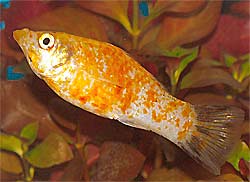
24 Karat Gold Molly Photo Courtesy David Brough
Molly species:
- Common or Short-finned Molly Poecilia sphenops
The Common Molly is the smallest of the three and has fins that are rounded and compact. The males are generally slim, elongated and smaller than the females, which are notably plumper. In aquariums, males will reach around 3 inches (8 cm) with females closer to around 4 – 5 inches (10 – 12 cm). Their natural adult size in the wild is closer to 8 inches (20 cm), though this much growth is unlikely in captivity.
Several subspecies and color varieties are available, but their prominent natural color is blue, often with yellow or red fins. Males are generally more colorful than females.
The popular “classic” Black Molly, a selectively bred Short-finned Molly, appeared in 1909 in Europe. It was first developed in the United States in the 1930s. Its back was usually olive brown and the sides could be silvery with a green or blue luster marked with a series of brown or orange dots. Though it was first a small-finned Molly, it was later crossbred to produce a large-finned Molly in about 1976. The popular Lyretail Molly varieties also belong to this species. These selectively-bred fish are not as hardy as the original fish, being more susceptible to disease and needing warmer water. - Sailfin Molly Poecilia latipinna
The Sailfin Molly, also known as the Topsail Molly, is one of the most attractive Mollies. It is similarly shaped to the Common Molly but is somewhat more laterally compressed. The dorsal fin is very large and much more rectangular in shape than that of the Common Molly. This fin can have dark rectangular spots for displaying. The Sailfin Molly can grow up to 8 inches (20 cm) in the wild, but reaches only about 4 – 5 inches (6 – 12 cm) in the aquarium.
This species has many varieties with different color variations. The prominent wild coloration is a green body with black dots, but it can also vary with melanistic, leucistic, and albino. Speckled forms are also common. The “Midnight Molly” is a selectively bred all black variety of the Sailfin Molly. - Mexican Sailfin Molly Poecilia velifera
The Mexican Sailfin Molly is also known as the Giant Sailfin Molly and the Yucatan Molly. Its shape, color, and large sail-like dorsal fins on the males make it difficult to distinguish from the Sailfin Molly, but the Mexical Sailfin Molly’s fins differ slightly, having small round light spots on the dorsal when displaying. This fish can reach 6 inches (15 cm) or so in the aquarium, which is about two inches shy of its size in the wild. The prominent natural color is usually a green body often with dark dots, and there is also an albino strain.
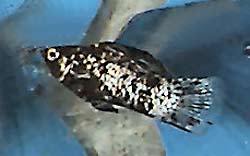
Sailfin Molly Photo Courtesy David Brough
Distinguishing Molly species:
Nearly all of the Mollies sold to aquarists these days are hybrids of two or more of these three species. It’s almost to the point that it is difficult to attach a Latin name to most of them. Identifying wild-caught Mollies is less difficult.
- Fin size
Fin size is one way to distinguish these fish. Mollies fall into one of two groups.The first group, which includes the Common Molly, has small fins, while the second group, including the two sailfin types, has large fins. - Fin location
Another easy way to distinguish between the short fin and sailfin groups is by the location of their dorsal fins. On Sailfin Mollies, the dorsal fin is situated in front of the anal fin, while on Common Mollies, this fin starts behind the anal fin.
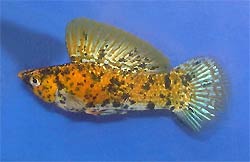
Cremecicle Calico Sailfin Molly Photo Courtesy Ken Childs
Distinguishing between the two types of Sailfin Mollies is more difficult because their coloring is very similar. The Sailfin Molly P. latipinna may be distinguished from the Mexican Sailfin Molly P. velifera by having dark rectangular spots in the dorsal fin while the spots on P. velifera are lighter in color and round. Often, however, they can only be distinguished by the number of rays on the dorsal fin. The Sailfin Molly P. latipinna has approximately 14 rays while the Mexican Sailfin Molly P. velifera will have closer to 18 rays.
Selectively bred Mollies:
Most mollies available today are selectively bred and are often hybrids. The fish we see are usually beyond the point of clearly belonging to any of the three original species.
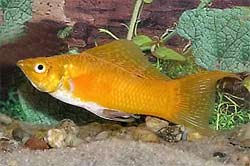
Cremecicle Lyretail Molly Photo Courtesy Ken Childs
The years of selective development of these three, however, has produced a myriad of fantastic colors and patterns. They range from the solid ebony of the Black Molly, to the orangey rusted speckles of the Sunburst Molly, and the spotted Silver Molly, to name just a few. The albino coloring comes from the “sailfin” species.
Body and fin shapes have also been selectively bred. These fish can now have a more stout body shape, lyre tails, and many other interesting features.
Most often the large-fin types are cross breeds of the Short-finned Molly P. sphenops and the Sailfin Molly P. latipinna. These cross breeds include the Lyretail, Moonfish, and Flag.
The Lyretail Molly has all normal fins except for the tail, which is long with even longer outside edges. The tail tends to lose its lyre shape as the fish get older.
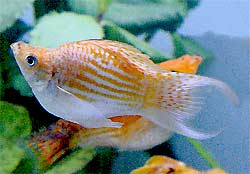
Cremecicle Lyretail Balloon Molly Photo Courtesy David Brough
The Veiltail Molly has a long tail and dorsal fin. Sometimes the fins on this fish are so long that they have trouble swimming. Both the Lyretail Molly and the Veiltail Molly are more difficult to breed due to having a very long gonopodium.
A very unique variety is the Balloon Molly. This fish was bred to be extremely short and round. The breeding causes an unnatural curvature of the spine. Unfortunately, this has been known to cause a great deal of internal organ damage and can shorten their lifespan dramatically. Sadly, this already deformed species is also frequently subjected to artificial dyeing processes, usually with needle injections, which can cause permanent damage to the Balloon Molly and a higher mortality rate.
Wild Mollies are very hardy, but many fish available in the hobby today are genetically weak and prone to disease due to the years of inbreeding and intense production. Most can be expected to live around 3 to 5 years with good care.
- Size of fish – inches: 8.0 inches (20.32 cm) – Few mollies will grow over 6 inches in the home aquarium; however, certain species may reach up to 8 inches in the wild.
- Lifespan: 3 years – On average, these fish will live about 3 years, but if well cared for, they can live up to about 5 years.
Fish Keeping Difficulty
The Molly is a fairly easy fish to care for provided that just a few requirements are met. Mollies do not do well in polluted water and are slightly more are prone to ich, fungus, and other diseases than other fish. They are also more susceptible to the shimmies in overcrowded conditions.
For beginners, the Common Molly P. sphenops and its hybrids are the best choice. They are the most durable, least demanding, and can be kept in smaller aquariums. The next best choice is a cross breed of Short-finned and Sailfin. The Sailfin Mollies, though often more peaceful, are a bit more challenging to keep as they are more delicate. Sailfin Mollies need a larger aquarium with plenty of room. The Mexican Sailfin Molly P. velifera is a bit more difficult to maintain than the other two species and their hybrids. They have a much lower tolerance for suboptimal or fluctuating aquarium conditions.
Make sure you select only healthy fish. Then provide a good tank with proper tankmates and a varied diet to offset any potential problems. The males are quite relentless in their pursuit of mates, so keeping them in a ratio of 1 male with 2-3 females helps alleviate stress. Sailfin Mollies also do better when kept with other livebearers that can handle a saline environment.
Balloon Mollies will tend to have a shorter lifespan due to their suboptimal body shape and the high degree of inbreeding. This fish is also not particularly disease resistant and as such should be spared the fluctuations of a newly set up aquarium.
- Aquarium Hardiness: Moderately hardy
- Aquarist Experience Level: Beginner
Foods and Feeding
These fish are considered omnivorous, but Mollies have a very high herbivorous requirement, and their diet needs to include lots of algae and other vegetation. In the wild, their diet consists mainly of algae, with rotifers, small crustaceans, and aquatic insects making up a smaller part.
In the aquarium, they will happily eat most prepared and live foods. The Molly appreciates a greater vegetable component in its diet. In fact, the development of the dorsal fin of the Sailfin Molly males may be impaired it there are insufficient vegetable foods provided. A vegetable flake along with blanched spinach or cucumber is a great way to do this, although any uneaten vegetable matter must be removed quickly. Mollies will also snack on aquarium plants and certain types of algae.
Mollies will enjoy proteins, but they can not subsist on them. Offer brine shrimp (either live or frozen), tubifex, or blood worms as a treat. A vitamin rich diet encourages the best coloration.This fish should be fed a varied diet several times daily in small amounts.
- Diet Type: Omnivore – Although this fish is an omnivore, it requires a high vegetable component to its diet. It is a good idea to supplement with blanched greens like spinach.
- Flake Food: Yes
- Tablet / Pellet: Yes
- Live foods (fishes, shrimps, worms): Some of Diet
- Vegetable Food: Most of Diet
- Meaty Food: Some of Diet
- Feeding Frequency: Several feedings per day – Feed small amounts several times a day, or what the fish can consume in about 3 minutes each time.
Aquarium Care
Mollies are not suited to small or overcrowded tanks but are usually fairly durable as long as the aquarium is maintained. The pH and hardness should both be kept on the higher end. If the pH swings too low due to pollution, the Molly will suffer greatly. The tank should have regular water changes of 25% every 2 -4 weeks. It will need more or less depending on how many fish there are and the condition of the water.
It is also advisable, as with most of this family, to add 1-1.25 teaspoons of aquarium salt per gallon. Remember to only replace water with salted water if one has removed water from the tank. Evaporated water leaves salts behind, so there is no need to add more salt if one is simply topping off evaporated water.
- Water Changes: Monthly – Do water changes of 25% every 2-4 weeks, and more often with heavily stocked tanks.
Aquarium Setup
All Mollies need an aquarium that is well-planted and not overcrowded. These moderately-sized, active fish need plenty of swimming space. A 20 gallon tank is the smallest tank advisable for the larger Sailfin Mollies. The Common Molly could go down to 15 gallons if there are only a few small companion fish in the tank. A single sex group or a one-to-three ratio of males to females is preferable to reduce quarrels among the males over potential mates. If both sexes are housed in the aquarium, the aquarist should plan for monthly breeding from these prolific fish.
Most Mollies do best in slightly brackish conditions. However, Mollies can live perfectly well in freshwater as long as it is not too soft and acidic. In a freshwater tank, the water needs to be hard and alkaline for the Mexican Sailfin Molly P. velifera, but they can do equally well in brackish conditions.
Disease resistance appears to be improved by the addition of 1-1.25 teaspoons of aquarium salt per gallon. Evaporated water leaves salts behind so there is no need to add more salt if one is topping off evaporated water. The Common Molly P. sphenops and its hybrids can even live a happy life in a fully saltwater environment, which makes these fish a popular choice to cycle new marine aquariums. The Mexican Sailfin Molly P. velifera can also be acclimated to fully marine conditions without much difficulty.
Most types of gravel work fine for a substrate, though lighter gravel will show their colors best. Good filtration is very helpful in maintaining stable water. Filtration systems remove much of the detritus, excess foods, and waste, which helps keep the tank clean and maintain the general health of the fish. The Mexican Sailfin Molly P. velifera is a bit more difficult to maintain than the other two species and their hybrids. They have a much lower tolerance for suboptimal or fluctuating aquarium conditions. Good water quality is also essential for the males to develop their best colorations.
The Molly appreciates some plants in the aquarium for cover and supplemental nutrition along with some open space for swimming. However, these are highly vegetarian fish, so choose plants with care. Soft-leaved plants may be destroyed. The use of breeder traps is hazardous to these fish, and it is recommended that you provide floating plant cover for the fry instead. Avoid too much driftwood as these livebearers do not like acidic water.
- Minimum Tank Size: 20 gal (76 L) – A single individual could be kept in a fifteen gallon tank with some company, but for a group of 4 or more, a larger tank is needed. Twenty gallons is the smallest tank advisable for the larger Sailfin Mollies.
- Suitable for Nano Tank: Yes
- Substrate Type: Any
- Lighting Needs: Moderate – normal lighting – The Molly does not have strong lighting preferences.
- Temperature: 70.0 to 82.0° F (21.1 to 27.8° C) – This temperature range is fine for the Short-finned (P. Sphenops) and Sailfin Molly (P. Latipinna), but the Mexican Sailfin Molly (P. velifera) likes a bit warmer tank range of 72-82°F (22-28°C).
- Breeding Temperature: 79.0° F
- Range ph: 7.0-8.5 – These values are acceptable for the Short-finned (P. Sphenops) and Sailfin Molly (P. Latipinna). The Mexican Sailfin (P. Velifera) should be kept within the range of 7.5-8.2.
- Hardness Range: 20 – 30 dGH – The Mexican Sailfin Molly (P. Velifera) should be kept in water with a hardness of at least 25, and up to 35.
- Brackish: Sometimes – These fish have a very high salt tolerance, and it is considered beneficial to add 1-1.25 teaspoons of aquarium salt per gallon.
- Water Movement: Moderate
- Water Region: All – These fish will swim in all areas of the aquarium, but mostly in the middle and top.
Social Behaviors
The Molly is generally peaceful but an active swimmer. These social fish like to be kept with their own kind or at least with members of the livebearer family. The males will occasionally squabble amongst themselves but generally without any damage done.
This fish is considered a good community fish. In general, Mollies are peaceful, though it has been noted that behavior is very individual. Some Mollies are markedly more aggressive than average. Males will establish a clear hierarchy and more dominant individuals might extend the hierarchy over other tankmates.
This fish can be housed with fish of similar temperament with the same water chemistry requirements; however, very small fish will probably be chased around. These fish should be kept with other fish that can tolerate the same type of water conditions, hard alkaline or brackish water. They are best kept with robust but not aggressive tankmates.
Mollies can fin-nip, and they themselves can have quite extensive fins, which can be very tempting for fin-nippers like Tiger Barbs. It’s best to avoid combining Mollies with other fin-nipping types, and ideally they should not be kept with other long-finned fish. Good tankmates include members of the Poecilia genus, other livebearers, Armored catfish (Corydoras), and some Rainbowfish. Other good companions are Barbs and other Cyprinids, as well as Tetras and other Characins that are hard water tolerant.
- Venomous: No
- Temperament: Peaceful – In general, mollies are peaceful, though that behavior is very individual. Occasionally, you will get a fish that can be quite ornery.
- Compatible with:
- Same species – conspecifics: Yes – Males will establish a clear hierarchy and quarrel over potential mates. It’s best to keep one male for every 2-3 females.
- Peaceful fish (): Safe
- Semi-Aggressive (): Monitor
- Aggressive (): Threat
- Large Semi-Aggressive (): Threat
- Large Aggressive, Predatory (): Threat
- Monitor
- Shrimps, Crabs, Snails: Safe – not aggressive
- Plants: Monitor – These are highly vegetarian fish, so any soft-leaved plants may be destroyed.
Sex: Sexual differences
The male is slender and has a gonopodium, a modification of the anal fin into a rod shape which is used in the reproductive process. Male Sailfin mollies have a long sail-like dorsal fin. The female is larger and rounder when fully grown.
Breeding / Reproduction
This livebearing fish breeds readily in the home aquarium, and the young reach sexual maturity at a very young age. For breeding Mollies, little more is required than to introduce both sexes into the aquarium. In fact, they can quickly overpopulate an aquarium. Some of the Veiltail and Lyretail Molly varieties may have difficulty breeding, however, since their selective breeding for extended fins has also made the gonopodium excessively long.
It is recommended to keep this species in a ratio of one male with at least 2-3 females, as the males can be quite vigorous in their pursuit of mates.To selectively breed Mollies, provide a breeding tank that is a minimum of 20 gallons for the Common MollyP. sphenops. At least 50 gallons will be needed for the larger Sailfin mollies. The water temperature should be about 79°F (26°C). Provide excellent filtration and good lighting to stimulate algae growth. The gestation period is about 28 days.
In a community aquarium, the young will be consumed by other tankmates unless they are removed, isolated, or simply given enough hiding spaces with densely rooted or floating plants. The use of breeder traps is hazardous to these fish, so floating pant covers are recommended for the fry instead.
The female Common Molly P. sphenops can have between 20 to 150 fry, and the female Sailfin Molly P. latipinna will generally produce 10 to 100 fry. The Mexican Sailfin Molly P. velifera can produce as many as 200 fry, but 20-60 young is more common. For more information, see the guide for breeding Livebearing Fish: Breeding Freshwater Fish – Livebearers.
- Ease of Breeding: Easy – Most Mollies are easy to breed, but the Mexican Sailfin Molly P. velifera is a bit more difficult.
Fish Diseases
The Molly seems to have a slightly lower resistance to fungal infections and Ich than other fish. They will also get the shimmies, a disorder which causes them to shiver and shake. Both of these can be prevented and treated by the addition of 1 to 1.25 teaspoons of aquarium salt.
Mollies are subject to the same diseases as other tropical fish. The best way to proactively prevent disease is to give them the proper environment and a well balanced diet. The more closely the aquarium mimics their natural habitat, the less stress the fish will have, making them healthier and happier. A stressed fish is more likely to acquire disease.
Anything you add to your tank can introduce disease. Not only other fish but also plants, substrate, and decorations can harbor bacteria. Take great care and make sure to properly clean or quarantine anything that you add to an established tank so as not to upset the balance. For information about fish diseases and illnesses, see Aquarium Fish Diseases and Treatments.
Availability
Mollies are some of the most universally available fish and have a relatively low cost. Wild-caught Sailfin Mollies can be found at specialty stores or online.
References
- Animal-World References: Freshwater Fish and Plants
- Poecilia sphenops (Valenciennes, 1846) Molly, Fishbase
- Poecilia latipinna (Lesueur, 1821) Sailfin molly, Fishbase
- Poecilia velifera (Regan, 1914) Sail-fin molly, Fishbase
- Poecilia vetiprovidentiae, IUCN Red List of Threatened Species. (Both Eschmeyer and FishBase note this species as a synonym of Poecilia sphenops.)
- Poecilia latipinna, IUCN Red List of Threatened Species
- H. Hieronimus, Guppies, Mollies, and Platies, Complete Pet Owners Manual Series, Barron’s, 2009
- Dr. Herbert R. Axelrod, A Complete Introduction to Community Aquariums , T.F.H. Publications, Inc., 2009
- Neale Monks, Brackish Water Fishes: An Aquarist’s Guide to Identification, Care & Husbandry, TFH Publications, 2006
- Glen S. Axelrod, et al, Encyclopedia Of Exotic Tropical Fishes For Freshwater Aquariums, TFH Publications, 2005
- David Alderton, Encyclopedia of Aquarium and Pond Fish , DK Publishing, Inc., 2005.
- David Goodwin, The Practical Aquarium Fish Handbook , Sterling Publishing Company, 2003.
- Dick Mills, Derek Lambert, Aquarium Fish Handbook, Quatro Inc., 2004.
- Marc Ladonne, Aquarium Fish , Barnes Noble, 1999 (1996).
- Harro Hieronimus, Guppies, Mollies, Platies, A Complete Pet Owners Manual, Barron’s, 1993
- John Gilbert, Raymond Legge, The Complete Aquarist’s Guide to Freshwater Tropical Fishes, Golden Press, 1970
WFLi_Ap8AF.jpg)